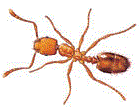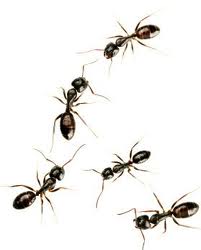
Tel No: 07769620549
Ants
Common Black Ant
Scientific Name: Lasius Niger
Introduction: There are many thousands species of ants known to man. The most common ant in Britain is the black garden ant otherwise known as the Common Black Ant which prefers a diet of sweet food. We usually see them in our gardens, around the walls, underneath stones, pavement, buildings and sometimes in our kitchen. Common black ants have a well design social structure. Usually the ants that we see in search of food are the worker ants and infertile female ants.
Recognition: The garden ants are dark brown or black in colour and about 3-
Biology: Egg>Lava>Pupa>Adult. Every nest has only one queen and all the eggs are
being laid by her. The nest may survive for many years, but young queens and matured
males leave the nest as" flying ant" in order to mate and start their own colony.
Mating of black ants takes place during warm summer days of July and August. This
swarm of ants often occurs when many nest at the same time in the afternoon and can
be seen flying around which last a few hours. The mating occurs on the wing and eventually
the ants will settle after being exhausted. After mating the male dies and the newly
fertilised queens will create a cell for her new colony. The newly fertilised females
will lay her first set of eggs in late spring which takes about three to four weeks
for hatching. When hatched, the ant larvae are white and legless; the female feeds
them with nourishing secretions from her salivary glands. It takes about 3 weeks
in order for full grown larvae to pupate. The pupa (nickname) "ant eggs" will developed
in 2 weeks into a full grown ant. This first generation of worker ants will take
on their duties of foraging for food such as dead insects, seeds, nectar and sugary
substance etc. The queen spends all her time in the nest laying eggs and tending
to her young. The workers are also responsible for rearing the young or larvae and
keeping the nest clean, removing any dead ants or debris. The black garden ant workers
are about 3-
Habits: Common black ants are very active at all times of the day in search of food. When ant colonies are formed in close proximity, one female will assume dominance and will kill the other female to take over her colony. They will travel a considerable distance in search of a suitable food supply marking their trail along the way and communicating with other ants by tapping them with their antennae. Outdoors worker ants will excavate the soil in order to make it a suitable home for them to breed and live.
Potential harm: The common black ant is not known to transmit any serious diseases. They can be a problem for gardeners as they will farm aphids (small plant feeding insect) for the honeydew (sugar rich substance); they then carry them into their nest and carry them back out again when necessary. Black garden ants will also eat fruits. Since they are likely to crawl on unpleasant materials, they can contaminate food stuff especially sweet foods.
Control: Insecticide and baiting formulation can be used for controlling common black ants. Particular attention should be given to air vents, doors, windows and cracks and crevices. Proof or seal all entry points. Call today for more about London pest control or to arrange for pest exterminators
Argentine ant
Appearance: Brown to light brown; shiny. About 1/10-
Habitat: Argentine ant colonies live in moist areas near a food source, often in damp soil next to buildings, along sidewalks or beneath boards. They deposit trails continuously to ensure they do not waste time visiting the same area for food. When outdoor conditions are too wet or dry, Argentine ants invade buildings by trailing along plumbing pipes and shrub branches, utility lines and wires. They are very aggressive and will drive out native species of ants, making argentine ant control difficult.
Diet: Omnivorous; they prefer sweet foods such as the honeydew produced by aphids and mealybugs, but will eat almost anything, including meats, eggs, oils and fats.
Ant control: argentine ants: When argentine ant colonies are eliminated, new colonies
may quickly take their place. Argentine ant control is a multi-
Pharaoh Ant 
Appearance: Yellow to reddish; very small, 1/16-
Habitat: Pharaoh ants nest almost anywhere that provides protection. They are extremely opportunistic and have been found nesting in walls, furniture, appliances, between folded sheets, hollow curtain rods, inside irons and under roofing shingles. They have a high daily water requirement and prefer warm, humid areas close to food and water. Workers range widely from the nest and establish visible trails to food and water sources. They travel from room to room via hidden plumbing pipes and electrical wires.
Diet: Pharaoh ants are opportunistic feeders that will “swarm” on foods that appear within their foraging range, which is why pharaoh ant control often uses bait. Indoors, they feed on meats, nuts, cheese, honey, bread crumbs, meats, grease and pet bowls.
Ant control: Pharaoh ant control can be very difficult. Using contact insecticides will cause them to fracture or split into two or more colonies to survive. Baiting forging trails and suspected areas of activity is the most effective pharaoh ant control method. Do not spray or disturb ants or bait stations, and avoid using cleaners around bait placements as this can destroy the integrity of pheromone trails.

WTC Pest Control
WTC Pest Control works in the Leek, Cheadle Stoke on Trent, Biddulph, Stafford, Sandbach, Stone, Eccleshall, Newcastle Under Lyme, Uttoxeter, Macclesfield, Congleton areas.
| Moles |
| Wasps |
| Mice |
| Ants |
| Cockroach |
| Rats |
| Flies |
| Squirrels |
| Pigeons |
| Seagulls |
| Bees |
| Moths |
| Moles |
| Wasps |
| Mice |
| Ants |
| Cockroach |
| Rats |
| Flies |
| Squirrels |
| Pigeons |
| Seagulls |
| Bees |
| Moths |